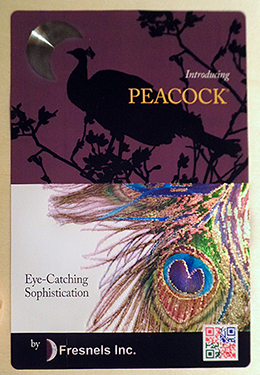Nanotechnology Foils | A New Packaging Design Vista
- Published: November 08, 2017, By Dr. Glenn Wood
The latest generation products exhibit dramatic color-switching patterns that create stunning new effects suitable for brand packaging.
 In the world of retail packaging, brand owners — and by extension the design houses that work for them — crave innovation. It appears that they’re always on the lookout for new ways to make sure that their products stand-out to consumers and radiate that all important brand appeal. “Unseen means unsold,” which signifies that the war for shelf space in retail outlets remains as hotly contested as ever.
In the world of retail packaging, brand owners — and by extension the design houses that work for them — crave innovation. It appears that they’re always on the lookout for new ways to make sure that their products stand-out to consumers and radiate that all important brand appeal. “Unseen means unsold,” which signifies that the war for shelf space in retail outlets remains as hotly contested as ever.
It might even be said brand owners are messianic about the need for eye-catching design enhancements and added value appeal, constantly applying pressure on printers and converters to show them engaging new features. And at the heart of the developments in this area is nanotechnology, which is having a profound influence on printing and packaging technologies and applications, particularly in the progress of advanced new printing materials and stamping foils.
Developments in foils have progressed so far that the latest generation products can exhibit dramatic color switching patterns, which in turn, create stunning new effects suitable for enhancing the appeal of branded packaging, especially folding cartons, opening up new horizons in the brand augmentation market and pushing the boundaries in contemporary design and thinking.
It could even be possible that these new stamping foils (hot and cold) now emerging will ultimately replace laminates as a way to add lens effects to labels and folding cartons for decorative impact. It’s already been shown on labels how our color changing foil can produce spectacular effects when used either alone or in conjunction with the lenses.
Indeed, at the recent Labelexpo Europe and LuxePack Monaco 2017 events, it was noticeable how many people commented on the foils and the similarity of the effect to that produced by color changing inks (OVIs) and used on many currencies around the world including the US $100 bill. In fact, color switch, especially green to gold, is easier to see than the security inks and much easier to apply. Either hot stamping foil or cold foil can be used to apply the foil to paperboard or plastic, thereby enhancing product shelf appeal.
From the point of view of the “path-to-purchase” in the retail environment, the positive effect of these nanotechnology foils will be seen on the shelves from a distance of a few feet. This is the raison d’etre for eye-catching, impactful packaging — its purpose is to distinguish the product from its neighbors on crowded shelves and draw in the prospective purchaser for closer examination. Retail studies and experts reveal that shoppers struggle to home in on the product they will ultimately buy, and this is where the foil can play an important role in engaging consumers and ultimately securing additional sales volumes, brand strength, and profit margins for the product owner.
Technologies such as the circular fresnel lens have proved enormously successful as an optical device for attracting attention, but they do have their drawbacks: It has only been possible to create the lens effect in relatively thick laminate material, which can be expensive, and in Europe, its use has become somewhat limited through association with a particular brand of champagne, whose box uses the feature to great effect.
OPTICALLY VARIABLE FOIL

This is leading to innovation in technologies that can be applied by brand owners, printers, and converters using standard foil application techniques, and which incorporate new optically attractive features that utilize core competencies in nanoscale engineering for visually exciting effects. Among these is a new optically variable foil (OVF) nanotechnology.
This new, easy-to-use, robust, and secure stamping foil has been inspired by the iridescence found in nature to deliver an arresting palette of colors and contemporary effects, which can be applied using standard foil application techniques. Providing a striking visual effect similar to optically variable inks (OVI), the new foils can be applied quickly and easily without the requirement for registration equipment, saving time and costs in the process.
The nanotechnology, which is easier to see and apply than traditional security inks, reflects the naturally occurring color variations seen in a peacock’s tail feathers — a dramatic spectrum of color changes running from iridescent greens to bright gold. The advanced color change features captured in the designs using the foil are difficult to replicate and can therefore be adopted for use as an added-value, cost effective foil-based brand protection feature for product susceptible to counterfeiting and piracy.
The technology also can be used to produce pairs of highly saturated iridescent colors for added design impact, producing the striking visual signals of bright iridescent colors that are common in other creatures: hummingbirds, peafowl, beetles, and butterflies.
These new technologies have to be seen as more than just another batch of consumables to add to the inventory of holographic foils, glitters, and metallics to add bling to packaging. They are a game-changing decorative effect, providing graphic and packaging designers with an entirely new tool to enhance branded packaging, especially for high-end goods already proud of the presentation of their products.
Because this new product is available in either transparent or fully metallized versions, it offers new opportunities to the printing industry to apply the effect either under the print (metallic version) or above the print (transparent version). Both methods open new graphic vistas for melding fixed color print with angular variability of color in visually stimulating ways.
ABOUT THE AUTHOR
Dr. Glenn Wood, Ph.D., is COO of Fresnels Inc. as well as the president and chairman of Wood & Associates Intl. Ltd. In an extensive career dedicated to the application of holographic technology to serious, commercial applications, he has been involved in all aspects of business development from product branding, packaging, international shipping to strategic planning, quality enhancement, and global marketing. Dr. Wood is a regular presenter at national and international conferences related to holography and new printing and converting technologies. He earned his Ph.D. in Photo Chemistry from Oxford University as well as his Masters Degree from Southampton University in the UK, also holds a B.S. from the University of St. Andrews, in Scotland. Contact him at glennpwood@yahoo.com; +01 7173477510.












